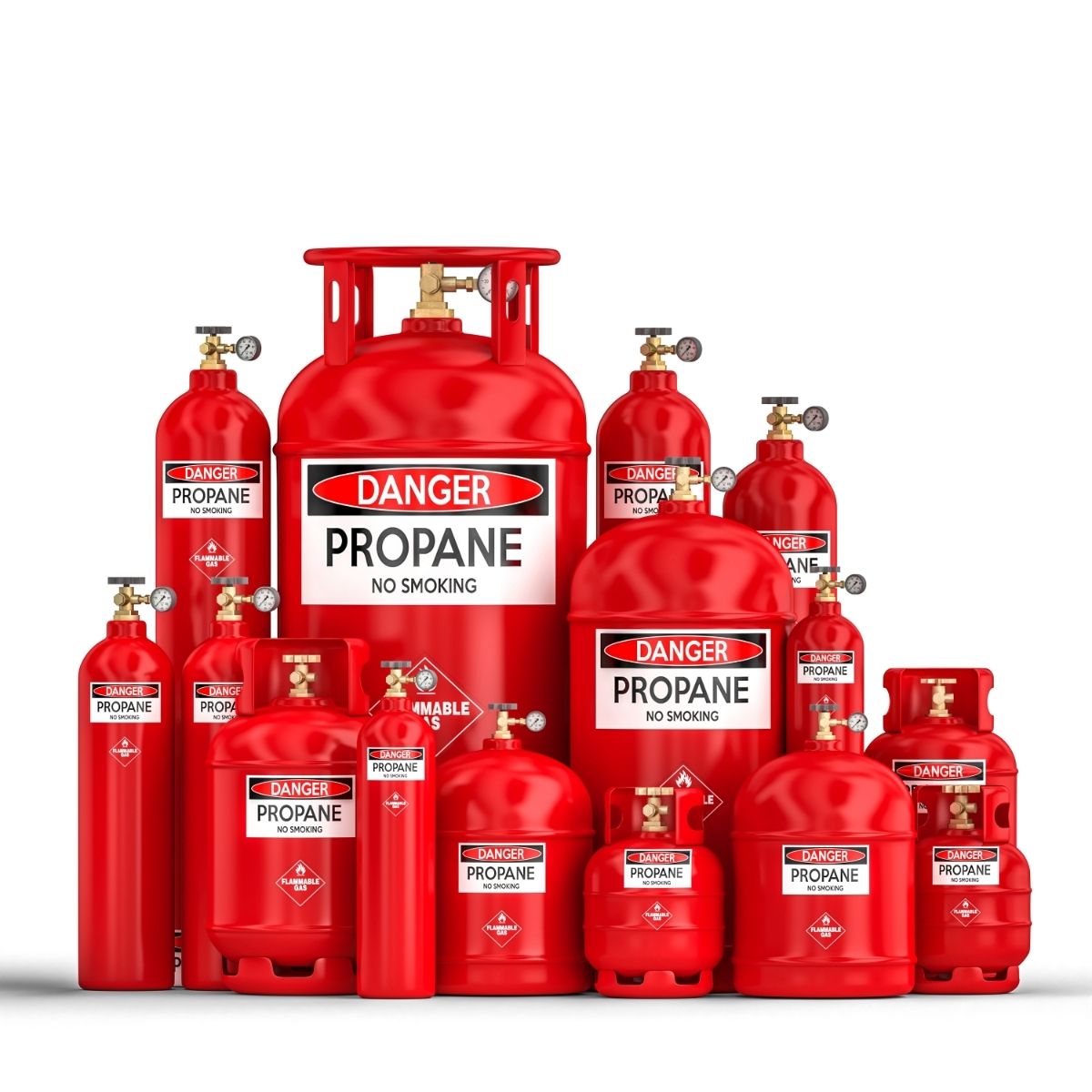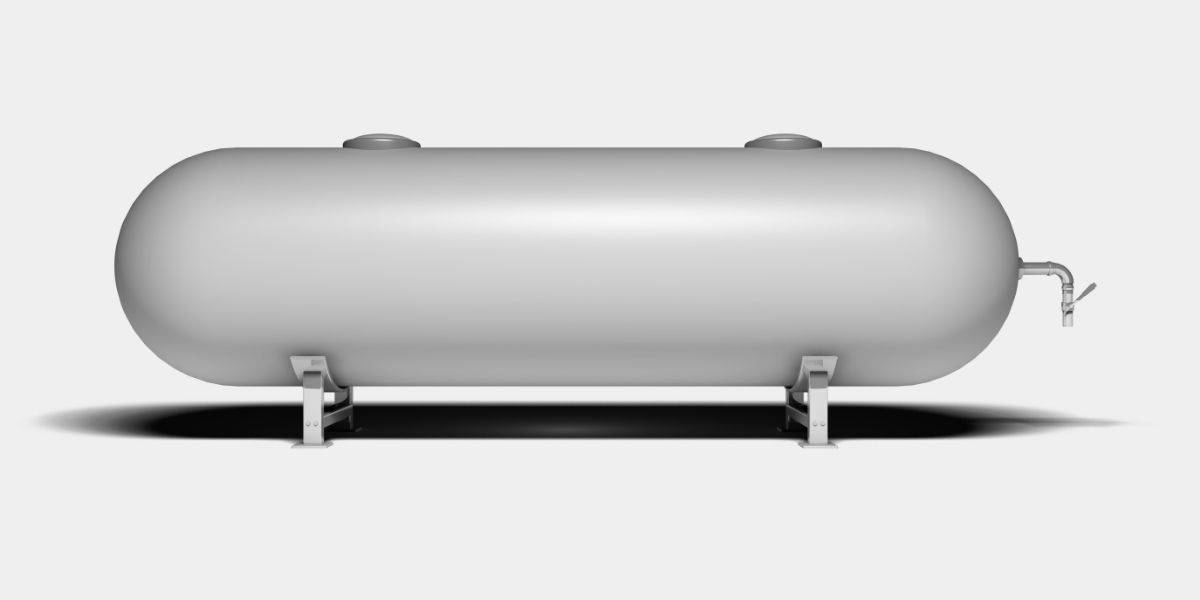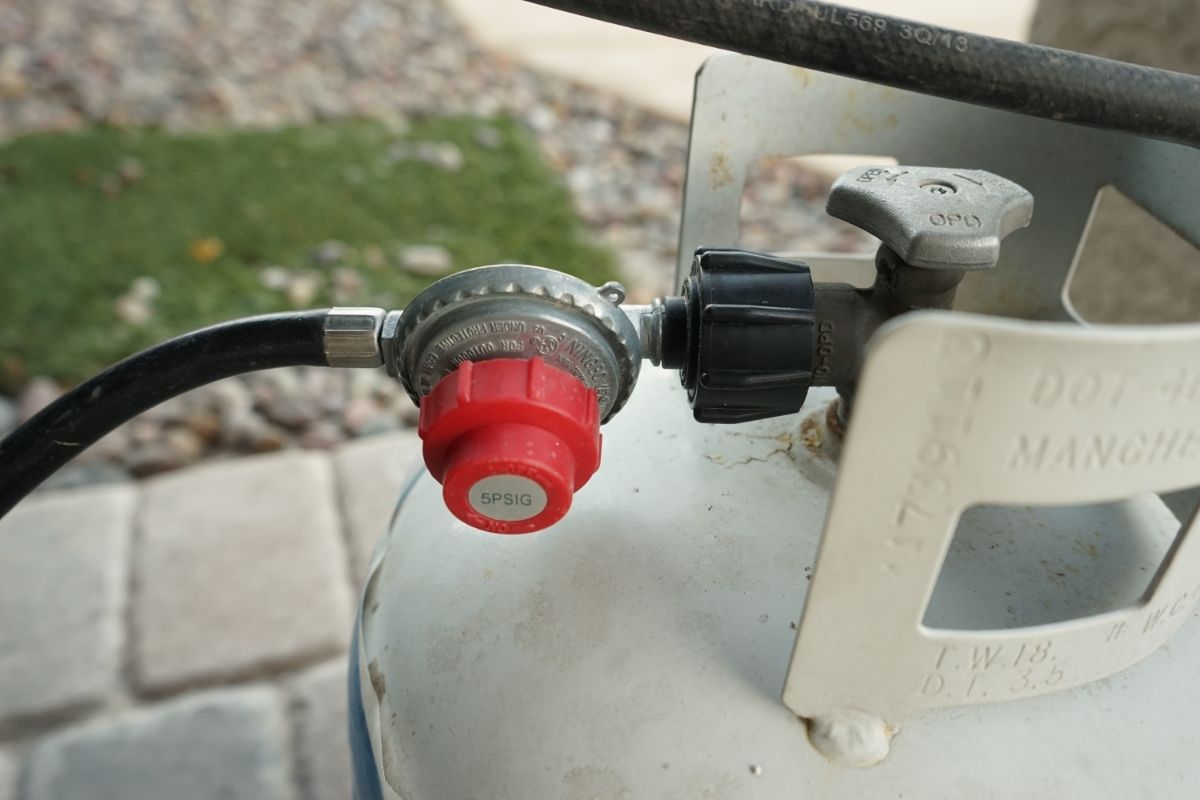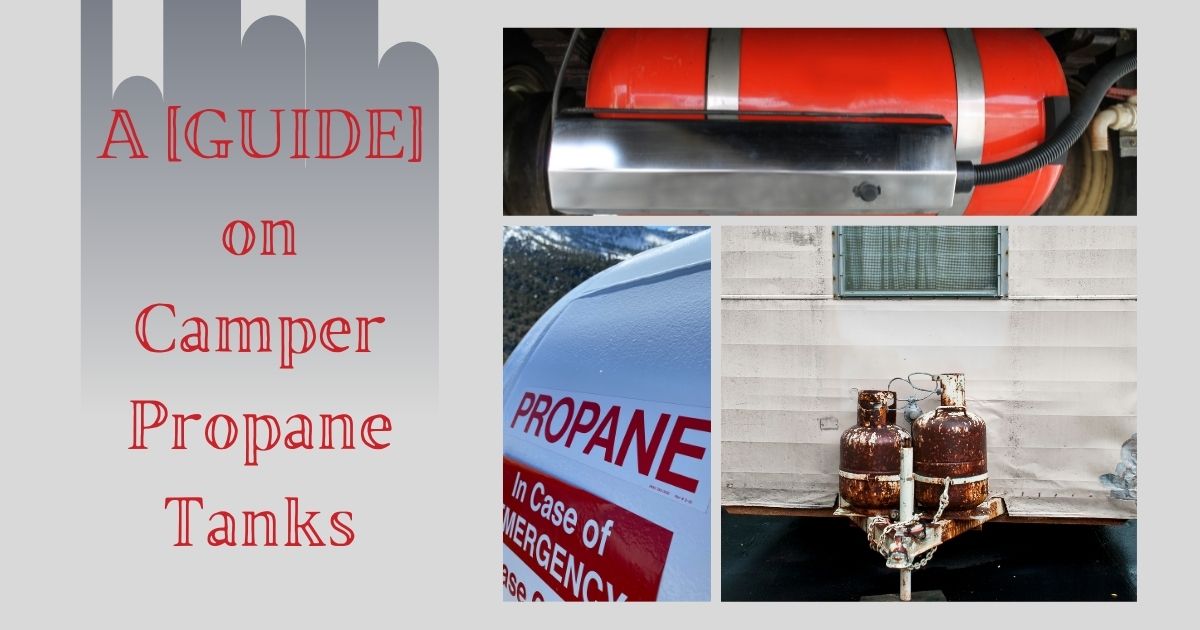If you enjoy spending time in the great outdoors, camper propane tanks are an essential part of your camper setup.
These tanks are used to fuel your stove, heater, or other appliances while you’re out camping. Without them, you wouldn’t be able to enjoy the comforts of your camper or prepare a nice meal to enjoy during your outdoor adventure!
If you’re looking into buying an RV propane tank, you have a lot of decisions to make. How big do you need your propane tank? What type of fuel should you use? Is there a cover you need to use?
This guide will answer all these questions and help you select the right propane tank for your outdoor needs!
Ready to get started? Let’s begin!
What is an RV Propane Tank Used for?
If you want to use your camper or recreational vehicle on the road, you need a propane tank to fuel your stove and other appliances.
Without these propane tanks, you’d be unable to enjoy the comforts of your camper or prepare your meals during your outdoor adventures.
RV propane tanks are vital for ensuring you have the best camping experience possible. They can be used to propane heaters, propane stoves, propane grills, propane fireplaces, and other appliances.
The Two Types of Camper Propane Tanks
There are two types of camper propane tanks: DOT cylinders and ASME tanks.
DOT Cylinders
DOT cylinders are the most common type of propane tanks for recreational vehicles. They’re approved by the US Department of Transportation and are small enough to transport easily.
These propane cylinders are not stationary, meaning it’s easy to move them or swap them out. You can also find these propane tanks in pairs, as they are smaller than most alternatives.
These DOT cylinders are approved for low-pressure applications, and they can handle a maximum pressure of 13.6 atm (200 psi).

ASME Tanks
The second type of camper propane tank is the ASME tank. These horizontal propane tanks are much larger than DOT cylinders, but they are permanently fixed to the camper.
ASME tanks are approved and regulated by the American Society of Mechanical Engineers, which means they can handle much more pressure.
These camper propane tanks are often used for motorhomes. They can be mounted horizontally, which allows you to use them for more than one appliance at a time.
ASME tanks may vary significantly in size and storage capacity. You can find these cylinders in both primary and reserve models. Make sure you get the correct type of tank for your RV needs!

RV Propane Tanks Sizes
If you’re looking for an RV propane tank replacement, you need to ensure that the propane cylinder is the right size and pressure.
There are a few types of RV propane tank sizes and pressure to keep in mind, but these two are the most common sizes:
320-ounce (9,071.85-gram) Propane Tanks
320-ounce (9,071.85-gram) propane cylinders are the most popular cylinders for RVs. They’re small enough to be easily transported from place to place, yet large enough to handle multiple appliances at once.
These propane tanks provide three-six hours of continuous use. They’re also very easy to find at gas stations and grocery stores. In addition, the RV propane tanks refill quickly, so you’ll be able to get back out camping in no time!
528-ounce (14,588.15-gram) Propane Tanks
If you need a bit more power out of your camper propane tank, you may want to consider a 528-ounce (14,588.15-gram) cylinder.
These tanks provide two times the amount of power as a standard 320-ounce (9,071.85-gram) tank, giving you up to 12 hours of continuous use.
While 528-ounces (14,588.15-gram) propane tanks are more powerful, they’re also a bit harder to find in stores. Instead, these tanks are often reserved for industrial use, so you’ll find them more commonly at propane dealerships and specialty shops.
Tank Gauges on Camper Propane Tanks
If you have a camper propane tank, it’s crucial to have a gauge that lets you know how much propane is left in the tank. Without a camper propane tank gauge, you could run out of gas and be stranded without power or heat!
Fortunately, there are camper propane tank gauges that are easy to find. If you have an ASME tank, there’s a good chance you will find an RV propane tank gauge built into it. These gauges have a needle showing how much propane is left in the tank.
If you have a DOT cylinder, there are aftermarket gauges you can purchase. However, these come in many different styles, so it’s essential to buy the right one for your camper propane tank.
Remember that built-in RV propane tank gauges can vary significantly in quality. You’ll get the best results from your camper propane tanks if you get a propane tank gauge made by the same manufacturer.
A few other factors that determine which RV propane tank gauge is right for you:
- Reliability of the indicator.
- Pricing on the gauges.
- Type of propane tank.
With proper knowledge of propane safety and appropriate camper propane tank gauges, you can use your camper with ease!
Camper Propane Tank Covers
If you’re sick of looking at that propane tank, it may be time to invest in a camper propane tank cover. These covers are designed to make your propane cylinder blend in with the rest of your RV decor.
There are many different styles and materials used to make propane tank covers, so it’s essential to find one that matches your RV. Here are some of the most popular propane tank cover materials:
- Plastic propane tank covers
- Polypropylene propane tank covers
- Stainless steel propane tank covers
Each material has its pros and cons, so make sure to pick the right one for you!
Camper propane tank covers are an inexpensive way to protect your propane tank. They’re also an excellent propane tank option if you have a propane cylinder that doesn’t blend well with the rest of your RV decor.
When you’re ready to buy your propane tank cover, there are a few things to keep in mind:
- Condition of your propane cylinder
- The exterior decor on your RV
- Number of camper propane tanks you have on your rig
With your propane tank gauge and propane safety knowledge, you’ll be able to get the most out of your camper propane tanks!
Tank Holders for RV Propane Tanks
If you prefer to store propane tanks outside your RV, it may be time to invest in propane tank holders. The right propane tank holder will keep your propane cylinder upright and stable.
Tank holders come with various propane tank holder designs, so making an intelligent propane tank purchase is essential. In addition, many propane cylinder holders are designed to hold a specific propane tank size, so make sure you buy the right one for your RV propane tanks.
Here are some popular propane tank holder designs:
- Wheeled propane tank holders
- Adjustable propane tank holders
- Fixed propane tank holder design
If you choose propane tank holders that are wheeled or adjustable, they will save you propane tank storage space. However, if you prefer fixed propane tank holders, they are a great option if you’re short on storage space.
Whether you prefer propane cylinder holders that are wheeled or propane holders that are fixed, make sure you pick the right propane tank holder for your RV propane tank. With propane safety knowledge and propane tank safety knowledge, you’ll have camper propane tanks for years to come.
RV propane tank holders are made of durable steel or aluminum. Each propane tank holder has a base plate, which is typically welded or bolted to the frame of your RV propane tank. The propane tank holder will then have a heavy-duty rod coming up from the propane cylinder, holding it in place.
What Should Know About Filling Your Camper Propane Tanks
Knowing the right propane tank filling process is essential if you have propane tanks on your RV. The propane tank filling process varies depending on what propane tank you have.
Refilling Your ASME Propane Tanks
ASME propane tanks are tanks mounted directly to your propane tank frame. To get your tank filled with propane, drive your RV to a propane dealer or propane station.
The propane dealer will attach a propane pump to your propane tank fill valve and fill your propane cylinders. Some propane dealers will let you refill your propane tanks, while others will ask their technicians to refill your propane tanks.
Always make sure to check with your propane dealer before you start. They can help you know what to expect and how they handle propane tank filling in your area.
Refilling Your DOT Cylinders
As mentioned earlier, DOT cylinders are not stationary. Therefore, these propane tanks can be removed from your RV and taken to a propane dealer or propane station for propane refilling.
If you are not near a propane dealer or propane station at a campground and are not near a propane station, you can always ask the campground host for help. Some campgrounds allow you to refill your camper propane tanks on-site, which is the safest option.
The campground host will likely have a propane filling station. However, it’s essential to check that the filling station is appropriately certified and inspected to ensure your safety.
The campground host may have a propane tank transport truck if they don’t have a propane filling station. This truck can help you refill your camper propane tanks. First, however, it’s essential to check that the truck is properly certified and inspected.
If your campground doesn’t have either of these options, they will at least be able to direct you to a nearby propane dealer or propane station.
FAQs on Camper Propane Tanks
Where Is the Propane Tank on an RV?
Your camper propane tanks will be stored differently depending on your RV setup. For example, many propane cylinders are located on the front of a trailer, whereas with motorhomes, propane cylinders are typically located under the coach.
Is It Cheaper to Exchange or Refill a Propane Tank?
You’ll likely get better value if you refill propane tanks than exchanging them. By having your propane cylinder filled at a propane dealer or yourself, you won’t have to pay the high cost of exchanging.
However, if your cylinder has expired, you’ll need to exchange it for a new propane cylinder. You can’t refill an expired propane cylinder. Check different RV propane tanks for sale online to find the right propane cylinder for your needs.

Do Horizontal Propane Tanks Require a Special Holder?
If your RV propane tank is horizontal, you will need a special holder for it. This particular holder has a base plate, which is then welded or bolted to the frame of your RV propane tank. This base plate will then have a heavy-duty rod coming up from the propane cylinder, holding it in place.
Can I Drive With the Propane On?
No, you must not drive with propane on. The propane tank should be turned off while your RV is in use. Using propane tanks while driving is hazardous and can lead to fires and explosions.
Where Can I Refill My RV Propane Tank?
You can refill your propane cylinder at any of the following locations:
- A propane dealer
- Your campground host (if your campsite has a refilling station)
- A propane tank transport truck (if you are at a campground)
- U-haul stores
- Hardware store
- A propane filling station at a gas station or anywhere else, if the area allows it.
How Long Do RV Propane Tanks Last?
This varies depending on the propane tank and how much propane it holds. However, a gallon (3.79 liters) of propane should last about four days if burned at 1000 BTUs per hour. So using less propane may get you more days out of a gallon (3.79 liters).
Many factors will affect how long your propane cylinders last. These include:
- How often you use propane.
- Your RV’s refrigerator and oven performance.
- The size of the tank (larger tanks will last longer).
- The BTU rating of your appliances.
Estimating a Camper’s Propane Usage
It’s essential to estimate how much propane your camper is using. This way, you’ll know when to refill your propane cylinder or exchange it for a new one. To do this, you’ll need to know how much propane you have in your propane cylinder and the propane cylinder’s BTU rating.
Keeping in mind that propane cylinders should only be filled up to 80% of their capacity, you can calculate your propane usage by following these steps:
- A gallon (3.79 liters) of propane contains 91,502 BTUs.
- A pound (0.45 kilograms) of propane contains 21,548 BTUs.
- Imagine a propane cylinder that holds 20 pounds (9.07 kilograms) of propane.
- So let’s calculate the total BTUs by multiplying 21,548 x 20. This equals 430,960 BTUs.
- Now add up the BTU demands of your appliances, such as your stove, refrigerator, and water heater. For example, let’s say that it adds up to 30,100 BTUs per hour.
- Next, divide 430,960 by 30,100 to get how long the propane cylinder will last when used at maximum capacity. This equals 14.4 hours. This means that your propane tank will last for about 14.3 hours when used at the maximum capacity.
Our Top Camper Propane Tank Tips
While propane tanks are an essential part while on the road, there are certain precautions you need to take when using them. Here are some top propane tank tips to ensure that you get the most out of your camper propane tanks while also being safe:
- Always keep a supply of propane in your RV if the camper propane tank has leakage or is empty. You don’t want to be stranded without a propane supply.
- Always be careful when handling camper propane tanks, and make sure never to take any unnecessary risks. Propane is highly flammable.
- Be careful not to overfill your RV propane tank. It’s best to keep RV propane tanks refilled about 80% full at most to allow room for propane expansion.
- When exchanging your camper propane tank, be sure to double-check that the cylinder’s serial number is the same as the propane tank you are exchanging it for. This will ensure that you’re using a brand-new propane cylinder and not an old one.
- Don’t use your RV propane tank while driving. Doing this is extremely dangerous and could cause fires and explosions.
- Always ventilate your RV when using propane indoors. Propane produces toxic fumes (carbon monoxide), which can be fatal if the air quality is insufficient.
- If your RV propane tank starts leaking or you think it may leak, do not use it. Replace the propane tank ASAP so that you don’t risk an accident.
- If your propane-fed appliance starts acting up or producing too many BTUs, turn the propane off and use another fuel source until you can repair or replace that appliance.
- Always store all propane tanks in a cool, dry place away from open flames or other heat sources.
- If you’re not going to use your RV propane tank for an extended period, be sure to drain all propane tanks and close the valves.
Buon Voyage!
Camper Propane tanks are an essential part of having a functional camper. Once you’ve taken the necessary precautions by equipping yourself with propane tanks and safety equipment, your next step is to get out there and hit the road!
Remember that sometimes it’s OK to go slowly when camping for the first time with your new RV. Try starting with local campsites to get the hang of all the equipment you’ll be using. Don’t forget to take frequent breaks and enjoy beautiful views along the way!
If you have any further questions on propane RV tanks, please comment below. We’ll be happy to answer your questions as soon as possible! For more information about camping and RVs, check out our blog!
